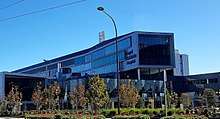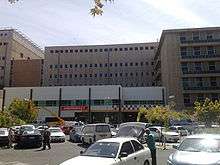Royal Adelaide Hospital
| Royal Adelaide Hospital | |
|---|---|
 | |
| Geography | |
| Location | Adelaide, South Australia, Australia |
| Organisation | |
| Care system | Public Medicare (AU) |
| Hospital type | General, Teaching |
| Affiliated university | University of Adelaide |
| Services | |
| Emergency department | Yes |
| Beds | 800 |
| Helipad | Yes |
| History | |
| Founded | NRAH opened on September 2017 and at the same time the older one closed |
| Links | |
| Lists | Hospitals in Australia |
The Royal Adelaide Hospital (RAH) is Adelaide's (and South Australia's) largest hospital. The RAH provides tertiary health care services for South Australia and provides secondary care clinical services to residents of Adelaide's city centre and inner suburbs.
History
Original hospital
| Royal Adelaide Hospital | |||||||||||||||||||||||||||||||
|---|---|---|---|---|---|---|---|---|---|---|---|---|---|---|---|---|---|---|---|---|---|---|---|---|---|---|---|---|---|---|---|
|
| |||||||||||||||||||||||||||||||
| |||||||||||||||||||||||||||||||
| Links | |||||||||||||||||||||||||||||||
| Lists | Hospitals in Australia | ||||||||||||||||||||||||||||||
The Adelaide Hospital was founded in the Adelaide Park Lands on the north side of North Terrace between Frome Road and the Adelaide Botanic Gardens in 1856,[2] and was officially proclaimed "Royal" on 2 November 1939.[3] It is adjacent to both the University of Adelaide and the University of South Australia. Its campus is also home to the University of Adelaide's Medical School, the Adelaide Dental Hospital, the Hanson Institute and SA Pathology.
Directions and wards
North Wing: The North Wing is home to wards R3-S3-S5 (Orthopedics), Q3 (Acute Surgical Unit) Q5 (ENT and Eyes), Q6 (Colorectal Surgery), Q7-R6 (Gastric and Upper GI Surgery), Q8—R7-R8-S7 (Medical), R4A (Spinal), R5 (NeuroSurgery), S6 (Breast and Endocrine Surgery, Urology), S2 (Thoracic Medicine), S8 (Geriatric medicine, Infectious diseases unit and Endocrinology) and S5 (Plastics).
East Wing: The East wing opened in the early 1960s and has 10 Wards for Psychiatry, Stroke, Renal, Oncology, Cardiology and Vascular Surgery, including A4-7, B5-8 and C3-6. Ward D6 is currently under redevelopment and a 9th floor is also being built. New lifts have been installed in the main foyer of the East Wing (which services the whole wing), with a further two in the process of being replaced. The East Wing also houses C-Max (private medical research company), the RAH Cancer Centre, and Outpatient Chemotherapy facilities.
Theatre Block: All of the 23 operating theatres are in this block. All of the treatment centres for the many specialties covered can also be found in this block, such as Nuclear Medicine and Cardio-Vascular Investigation Unit.
Emergency Block: The Emergency Department, along with Renal Centre (Dialysis) and other departments, is found in this block. The two Patient Transport Lifts (PTL), which are reserved for patient transport/medical equipment use only, are also in this block. The Emergency department underwent a total refurbishment in 2002-2003, in addition to an extension; it is now a state of the art Emergency facility with 4 specialised Resuscitation/Trauma Rooms, 5 patient care areas (Diagnostics, Admissions, short stay, psychiatric short stay and Fast Track) and also houses the Hospital's Radiology department. The Radiology department runs 24 hours a day and has 2 modern CT machines, two interventional angiography suites, multiple ultrasound and plain x-ray rooms. The Orderlies office is also located in Emergency, along with the ambulance entrance and Triage.
Outpatient: All specialist offices are found in the Outpatient blocks from levels 3-9. This block has access to the Hospital's helipad, via the Outpatient lifts.
Hone Wing: home to the Department of Radiation Oncology and holds 5 bunkers containing Varian linear accelerators.
McEwin Building: The McEwin Building is situated to the east of the hospital. It is home to the Sleep Disorders Laboratory, containing four beds (Level 6), and Transfusion (Level 5).
P Wing: This new wing holds the 3 unit 33 bed Intensive Care Unit, the Burns Unit (the only international Burns Unit to be verified by the American Burn Association) and PARU (Post-Anaesthetic Recovery Unit), all on level 4.
Residential Wing: This was built in the 1970s and was initially for students who would be working at the RAH too. However, later on, it was being used by many other students and patients relatives. Many floors were shut down in mid 2016, to prepare for the transfer to the new RAH.
Departments
Allied Health: Audiology, Clinical Dietetics, Clinical Pharmacy, Clinical Psychology, Health Promotion, Nutrition and Food Services, Orthotics and Prosthetics, Occupational Therapy, Physiotherapy, Podiatry, Social Work and Speech Pathology.
Department of General Services: The Department of General Services includes Security, Orderlies, Cleaning, Waste Management (Porters) and Parking. Their office is located in the Residential Wing.
Hyperbaric Department: The Royal Adelaide Hospital is the only provider of hyperbaric oxygen therapy in South Australia.[4] The Hyperbaric Medical Unit (HMU) has been in operation since 1985 and has been in its current location since 2001.[4][5] The principal treatment equipment is a pair of twin-lock, multiplace hyperbaric chambers. One of these chambers was the first rectangular steel chamber in Australia.[6][7] The HMU co-ordinates the Divers Emergency Service (DES), a telephone-based consultation service for diving-related matters within Australia, the Southern Pacific and Southeast Asia.[8]
Nursing Department: The Nursing Department oversees all nursing aspects of the Royal Adelaide Hospital.
New hospital
Completed in 2017, the new Royal Adelaide Hospital (nRAH) is located on a 10 hectares (25 acres) site within the Adelaide Park Lands, on the north side of North Terrace, west of Morphett Street.[9] It cost more than A$2 billion to construct, making it one of the most expensive buildings ever built.[10] 6,000 staff are expected to work at the hospital,[9] and all rooms are single patient suites with private bathroom facilities. There are 40 operating theatres, each measuring 65m2.[11] The nRAH will also be Australia's most technologically advanced hospital, with a fleet of automated robotic vehicles to help move supplies, meals and equipment around the hospital, and a tailor made patient electronic medical record (EMR). Other technology features including patient weighing beds, wireless technology and equipment tracking capability, and intelligent information systems such as bedside entertainment and meal ordering for patients.[12] For hospital staff, amenities will be supplemented by a commercial precinct including a crèche, mini-mart, restaurant, cafes and gymnasium.[13]
The hospital has been designed with a target of 50% reduction in greenhouse gas emissions compared to equivalent hospitals. A co-generation system uses waste heat from energy generators to provide the primary source of heating to the building's domestic hot water system. Orientation of the buildings is optimised to minimise solar thermal loads, with extensive daylight penetration to reduce artificial lighting requirements. Rainwater and stormwater harvesting is used to offset potable water requirements, along with extensive use of water sensitive landscaping and a water efficient thermal plant.[12]
The new RAH forms an integral part of Adelaide's new biomedical precinct, termed Adelaide BioMed City. Other recently completed facilities include the South Australian Health and Medical Research Institute (SAHMRI), the University of Adelaide Health and Medical Sciences building, the University of South Australia's Health Innovation Building, and Flinders University's John Chalmers Centre for Transforming Healthcare, including a Proton Therapy Unit.[14][15] There are plans for the New Women's and Children's Hospital to be co-located at this site.
The new RAH opened on 4 September 2017 and the Emergency Department opened on 5 September. On the same date, the original Royal Adelaide Hospital closed and some of the land occupied by the hospital will be returned to the Park Lands and incorporated into the Adelaide Botanic Gardens.[16] The Dental Hospital has already relocated to the new Hospital.[17] At the present time, the old RAH is being used by various entities, such as the Australian Defence Force and the Adelaide Fringe.[18][19] Demolition has already begun on some of the non-heritage buildings, such as the Hone Wing, Cobalt Wing, and the bigger East Wing.[20]
See also
References
- ↑ http://www.abc.net.au/news/2017-01-24/new-royal-adelaide-hospital-all-you-need-to-know/8206416
- ↑ "Royal Adelaide Hospital". The Advertiser (Adelaide). South Australia. 18 July 1939. p. 16. Retrieved 3 September 2016 – via National Library of Australia.
- ↑ ""Royal Adelaide Hospital" Now". The News. XXXIII, (5, 078). South Australia. 2 November 1939. p. 9. Retrieved 3 September 2016 – via National Library of Australia.
- 1 2 "Hyperbaric Medicine Unit". Archived from the original on 11 April 2013. Retrieved 3 April 2013.
- ↑ Acott, C (1992). "Clinical review Royal Adelaide Hospital hyperbaric medicine unit 1990". Journal of the South Pacific Underwater Medicine Society. 22 (1). Retrieved 2013-04-03.
- ↑ "Divers Emergency Service". Archived from the original on 2004-03-11. Retrieved 2013-04-03.
- ↑ Williamson, JA (1994). "Royal Adelaide Hospital Hyperbaric Medicine Unit: A progress report". Journal of the South Pacific Underwater Medicine Society. 24 (1). Retrieved 2013-04-03.
- ↑ "Hyperbaric Medicine Unit". Royal Adelaide Hospital. Archived from the original on 11 April 2013. Retrieved 17 April 2013.
- 1 2 HOME | SA Health Partnership
- ↑ Campbell-Dollaghan, Kelsey (5 December 2014). "Australia Has Two Of The Most Expensive Buildings Ever Built". Gizmodo Australia. Retrieved 26 December 2014.
- ↑ New Royal Adelaide Hospital, CPB Contractors
- 1 2 "New Royal Adelaide Hospital". www.designinc.com.au. DesignInc. Retrieved 2016-07-16.
- ↑ "New Royal Adelaide Hospital". www.cimic.com.au. CIMIC Group. Archived from the original on 7 July 2016. Retrieved 16 July 2016.
- ↑ "Adelaide BioMed City". www.healthindustries.sa.gov.au. Archived from the original on 7 August 2016. Retrieved 17 July 2016.
- ↑ "South Australian Health and Biomedical Precinct". Archived from the original on 2014-07-07.
- ↑ Hospital land may be turned into gardens, Sydney Morning Herald, 11 June 2007, Accessed 13/6/7.
- ↑ http://www.sahealth.sa.gov.au/wps/wcm/connect/public+content/sa+health+internet/health+services/dental+services/adelaide+dental+hospital/new+adelaide+dental+hospital%5Bdead+link%5D
- ↑ https://www.facebook.com/7NewsAdelaide/videos/1777463172284330/
- ↑ Greg Mackie (6 February 2018). "City of Collections? Old Royal Adelaide Hospital site must give the past a future". The Adelaide Review.
- ↑ https://www.news.com.au/national/south-australia/old-royal-adelaide-hospital-sites-heritagelisted-buildings-will-become-an-entrepeneurial-hub-as-others-are-demolished/news-story/ffda956ae91ef117583e4909ad41675a
